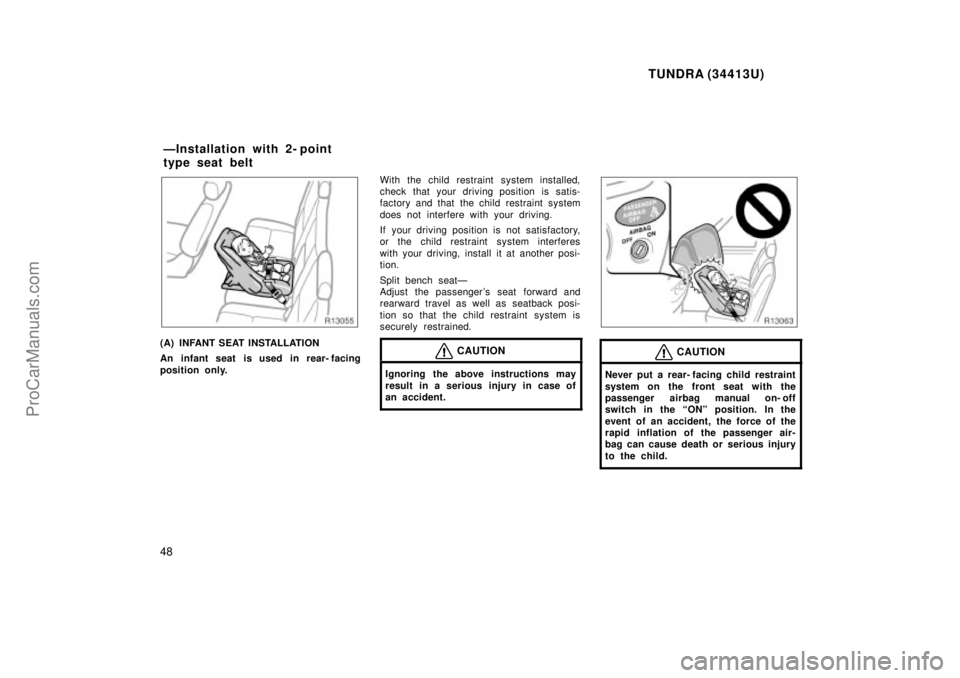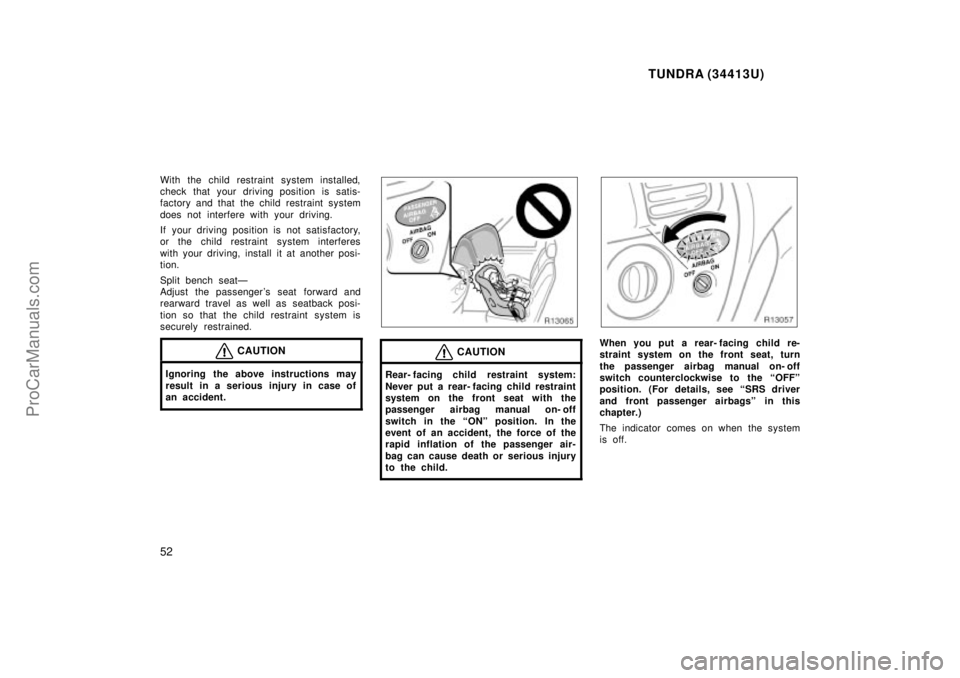Page 40 of 283

TUNDRA (34413U)
40
A crash severe enough to inflate the air-
bags may break the windshield as the
vehicle buckles. In vehicles with a pas-
senger airbag the windshield may also be
damaged by absorbing some of the force
of the inflating airbag.CAUTION
�The SRS airbag system is designed
only as a supplement to the prima-
ry protection of the driver side and
front passenger side seat belt sys-
tems. The front seat occupants can
be killed or seriously injured by an
inflating airbag if they do not wear
the available seat belts. During sud-
den braking just before a collision,
an unrestrained driver or front pas-
senger can move forward into direct
contact with or close proximity to
the airbag which may then deploy
during the collision. To obtain maxi-
mum protection in an accident, the
driver and all passengers in the ve-
hicle must wear their seat belts.
Wearing a seat belt during an acci-
dent reduces the chances of death
or serious injuries or being thrown
out of the vehicle. For instructions
and precautions concerning the seat
belt system, see Seat beltsº in this
chapter.
�Improperly seated and/or restrained
infants and children can be killed
or seriously injured by a deploying
airbag. An infant or child who is
too small to use a seat belt should
be properly secured using a child
restraint system. As to access cab
models, Toyota recommends that all
infants and children be placed in
the rear seat of the vehicle and
properly restrained. The rear seat is
the safest for infants and children.
For instructions concerning the
installation of a child restraint sys-
tem, see Child restraintº in this
chapter.
ProCarManuals.com
Page 45 of 283

TUNDRA (34413U)
45
Toyota strongly urges the use of child
restraint systems for children small
enough to use them.
The laws of all fifty states in the U.S.A.
and Canada now require the use of a
child restraint system.
Your vehicle conforms to SAEJ1819.
If a child is too large for a child restraint
system, the child should sit in the seat
and must be restrained using the vehicle's
seat belt. See Seat beltsº for details.
CAUTION
�For effective protection in automo-
bile accidents and sudden stops,
children must be properly re-
strained using a seat belt or child
restraint system depending on the
age and size of the child. Holding
a child in your arms is not a sub-
stitute for a child restraint system.
In an accident, the child can be
crushed against the windshield, or
between you and the vehicle's inte-
rior.
�STANDARD CAB MODELSÐ
Toyota strongly urges use of a
proper child restraint system which
conforms to the size of the child.
ACCESS CAB MODELSÐ
Toyota strongly urges use of a
proper child restraint system which
conforms to the size of the child
and is put on the rear seat. Accord-
ing to accident statistics, the child
is safer when properly restrained in
the rear seat than in the front seat.
�Never put infant or child age 1 to
12 in a passenger risk group on the
right front seat with the passenger
airbag manual on- off switch in the
ONº position. In the event of an
accident, the force of the rapid
inflation of the passenger airbag
can cause death or serious injury
to the child.
If you must put infant or child age
1 to 12 in a passenger risk group
on the right front seat, make sure
the passenger airbag manual on- off
switch is in the OFFº position and
that the indicator light is on. (For
details, see SRS driver and front
passenger airbagsº in this chapter.)
�Make sure that you have complied
with all installation instructions pro-
vided by the child restraint
manufacturer and that the system is
properly secured.
Child restraintÐ
ÐChild restraint precautions
ProCarManuals.com
Page 46 of 283

TUNDRA (34413U)
46
ÐChild restraint system
A child restraint system for a small
child or baby must itself be properly
restrained on the seat with either the
lap belt or the lap portion of the lap/
shoulder belt. You must carefully con-
sult the manufacturer 's instructions
which accompany your child restraint
system.
To provide proper restraint, use a child
restraint system following the manufactur-
er 's instructions about the appropriate age
and size of the child for the child restraint
system.
Install the child restraint system correctly
following the instructions provided by its
manufacturer of the system. General
directions are also provided under the fol-
lowing illustrations.
The child restraint system should be
installed on the rear seat if your vehicle
is equipped with rear seats. According to
accident statistics, the child is safer when
properly restrained in the rear seat than
in the front seat.CAUTION
�Never put infant or child age 1 to
12 in a passenger risk group on the
right front seat with the passenger
airbag manual on- off switch in the
ONº position. In the event of an
accident, the force of the rapid
inflation of the passenger airbag
can cause death or serious injury
to the child.
If you must put infant or child age
1 to 12 in a passenger risk group
on the right front seat, make sure
the passenger airbag manual on- off
switch is in the OFFº position and
that the indicator light is on. (For
details, see SRS driver and front
passenger airbagsº in this chapter.)
�After installing the child restraint
system, make sure it is secured in
place according to the manufactur-
er's instructions. If it is not re-
strained securely, it may cause
death or serious injury to the child
in the event of a sudden stop or
accident.
When not using the child restraint system,
keep it secured with the seat belt or place
it somewhere other than the passenger
compartment. This will prevent it from in-
juring passengers in the event of a sud-
den stop or accident.
Your vehicle has anchors for securing the
top strap of a child restraint system.
For instructions on how to use the anchor
bracket, see Using a top strapº in this
chapter.
ProCarManuals.com
Page 48 of 283

TUNDRA (34413U)
48
(A) INFANT SEAT INSTALLATION
An infant seat is used in rear- facing
position only.With the child restraint system installed,
check that your driving position is satis-
factory and that the child restraint system
does not interfere with your driving.
If your driving position is not satisfactory,
or the child restraint system interferes
with your driving, install it at another posi-
tion.
Split bench seatÐ
Adjust the passenger 's seat forward and
rearward travel as well as seatback posi-
tion so that the child restraint system is
securely restrained.CAUTION
Ignoring the above instructions may
result in a serious injury in case of
an accident.
CAUTION
Never put a rear- facing child restraint
system on the front seat with the
passenger airbag manual on- off
switch in the ONº position. In the
event of an accident, the force of the
rapid inflation of the passenger air-
bag can cause death or serious injury
to the child.
ÐInstallation with 2- point
type seat belt
ProCarManuals.com
Page 50 of 283
TUNDRA (34413U)
50
1. Run the center lap belt through oraround the infant seat following the
instructions provided by its manufactur-
er and insert the tab into the buckle
taking care not to twist the lap belt.
CAUTION
�After inserting the tab, make sure
the tab and buckle are locked and
that the lap belt is not twisted.
�Do not insert coins, clips, etc. in
the buckle as this may prevent you
from properly latching the tab and
buckle.
�If the seat belt does not function
normally, it cannot protect your
child from injury. Contact your
Toyota dealer immediately. Do not
use the seat until the seat belt is
fixed.
2. While pressing the infant seat firmlyagainst the seat cushion and seatback,
tighten the lap belt by pulling its free
end to hold the infant seat securely.
ProCarManuals.com
Page 51 of 283
TUNDRA (34413U)
51
CAUTION
Push and pull the child restraint sys-
tem in different directions to be sure
it is secure. Follow all the installation
instructions provided by its manufac-
turer.
3. To remove the infant seat, press thebuckle- release button.(B) CONVERTIBLE SEAT INSTALLATION
A convertible seat is used in forward-
facing and rear- facing position depend-
ing on the child's age and size. When
installing, follow the manufacturer's
instructions about the applicable child's
age and size as well as directions for
installing a child restraint system.
ProCarManuals.com
Page 52 of 283

TUNDRA (34413U)
52
With the child restraint system installed,
check that your driving position is satis-
factory and that the child restraint system
does not interfere with your driving.
If your driving position is not satisfactory,
or the child restraint system interferes
with your driving, install it at another posi-
tion.
Split bench seatÐ
Adjust the passenger 's seat forward and
rearward travel as well as seatback posi-
tion so that the child restraint system is
securely restrained.
CAUTION
Ignoring the above instructions may
result in a serious injury in case of
an accident.
CAUTION
Rear- facing child restraint system:
Never put a rear- facing child restraint
system on the front seat with the
passenger airbag manual on- off
switch in the ONº position. In the
event of an accident, the force of the
rapid inflation of the passenger air-
bag can cause death or serious injury
to the child.
When you put a rear- facing child re-
straint system on the front seat, turn
the passenger airbag manual on- off
switch counterclockwise to the OFFº
position. (For details, see SRS driver
and front passenger airbagsº in this
chapter.)
The indicator comes on when the system
is off.
ProCarManuals.com
Page 54 of 283
TUNDRA (34413U)
54
1. Run the center lap belt through oraround the convertible seat following
the instructions provided by its
manufacturer and insert the tab into
the buckle taking care not to twist the
lap belt.
CAUTION
�After inserting the tab, make sure
the tab and buckle are locked and
that the lap belt is not twisted.
�Do not insert coins, clips, etc. in
the buckle as this may prevent you
from properly latching the tab and
buckle.
�If the seat belt does not function
normally, it cannot protect your
child from injury. Contact your
Toyota dealer immediately. Do not
use the seat until the seat belt is
fixed.
2. While pressing the convertible seatfirmly against the seat cushion and
seatback, tighten the lap belt by pulling
its free end to hold the convertible seat
securely.
ProCarManuals.com